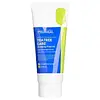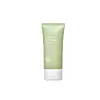What's inside
What's inside
 Key Ingredients
Key Ingredients

 Benefits
Benefits

 Concerns
Concerns

 Ingredients Side-by-side
Ingredients Side-by-side

Water
Skin ConditioningLaureth-1 Phosphate
Glycerin
HumectantLauryl Phosphate
EmulsifyingSodium Laureth Sulfate
CleansingPEG-120 Methyl Glucose Dioleate
EmulsifyingPPG-3 Caprylyl Ether
SolventLauryl Hydroxysultaine
CleansingGlycol Distearate
EmollientCetearyl Alcohol
EmollientMelaleuca Alternifolia Leaf Extract
PerfumingCitric Acid
Buffering1,2-Hexanediol
Skin ConditioningGlyceryl Stearate
EmollientPEG-100 Stearate
PEG-160 Sorbitan Triisostearate
CleansingAlcohol Denat.
AntimicrobialSodium Chloride
MaskingSodium Methyl Cocoyl Taurate
CleansingAcrylates/C10-30 Alkyl Acrylate Crosspolymer
Emulsion StabilisingPotassium Hydroxide
BufferingDimethicone
EmollientButylene Glycol
HumectantCaprylyl Glycol
EmollientMelaleuca Alternifolia Leaf Oil
AntioxidantEthylhexylglycerin
Skin ConditioningDisodium EDTA
Acanthopanax Senticosus Root Extract
Skin ConditioningCentella Asiatica Extract
CleansingPanax Ginseng Root Extract
EmollientAsparagus Cochinchinensis Root Extract
Skin ConditioningPolygonum Multiflorum Root Extract
Skin ConditioningLonicera Japonica Flower Extract
Skin ConditioningCamellia Japonica Seed Oil
EmollientWater, Laureth-1 Phosphate, Glycerin, Lauryl Phosphate, Sodium Laureth Sulfate, PEG-120 Methyl Glucose Dioleate, PPG-3 Caprylyl Ether, Lauryl Hydroxysultaine, Glycol Distearate, Cetearyl Alcohol, Melaleuca Alternifolia Leaf Extract, Citric Acid, 1,2-Hexanediol, Glyceryl Stearate, PEG-100 Stearate, PEG-160 Sorbitan Triisostearate, Alcohol Denat., Sodium Chloride, Sodium Methyl Cocoyl Taurate, Acrylates/C10-30 Alkyl Acrylate Crosspolymer, Potassium Hydroxide, Dimethicone, Butylene Glycol, Caprylyl Glycol, Melaleuca Alternifolia Leaf Oil, Ethylhexylglycerin, Disodium EDTA, Acanthopanax Senticosus Root Extract, Centella Asiatica Extract, Panax Ginseng Root Extract, Asparagus Cochinchinensis Root Extract, Polygonum Multiflorum Root Extract, Lonicera Japonica Flower Extract, Camellia Japonica Seed Oil
Water
Skin ConditioningZinc Oxide
Cosmetic ColorantCyclohexasiloxane
EmollientDibutyl Adipate
EmollientButyloctyl Salicylate
Skin ConditioningDipropylene Glycol
HumectantDicaprylyl Carbonate
EmollientPropylheptyl Caprylate
EmollientPolyglyceryl-4 Diisostearate/Polyhydroxystearate/Sebacate
EmulsifyingNiacinamide
SmoothingDisiloxane
Skin ConditioningBis-Ethylhexyloxyphenol Methoxyphenyl Triazine
Skin ConditioningMethyl Methacrylate Crosspolymer
Polyglyceryl-3 Polydimethylsiloxyethyl Dimethicone
Skin ConditioningDiethylamino Hydroxybenzoyl Hexyl Benzoate
UV FilterEthylhexyl Triazone
UV AbsorberTitanium Dioxide
Cosmetic ColorantDisteardimonium Hectorite
StabilisingMagnesium Sulfate
Triethoxycaprylylsilane
1,2-Hexanediol
Skin ConditioningPolymethylsilsesquioxane
Olea Europaea Fruit Oil
MaskingGlyceryl Caprylate
EmollientCaprylyl Glycol
EmollientEthylhexylglycerin
Skin ConditioningAdenosine
Skin ConditioningSodium Hyaluronate
HumectantMelaleuca Alternifolia Leaf Water
AntimicrobialAbies Sibirica Oil
MaskingTocopherol
AntioxidantRosmarinus Officinalis Leaf Oil
MaskingSalvia Sclarea Oil
MaskingAnthemis Nobilis Flower Oil
MaskingButylene Glycol
HumectantJuniperus Mexicana Oil
MaskingChamomilla Recutita Flower Oil
Masking4-Terpineol
MaskingMelaleuca Alternifolia Leaf Oil
AntioxidantGlycerin
HumectantLactobacillus Ferment
Skin ConditioningHydrogenated Lecithin
EmulsifyingCentella Asiatica Extract
CleansingFicus Carica Fruit Extract
HumectantCeramide NP
Skin ConditioningWater, Zinc Oxide, Cyclohexasiloxane, Dibutyl Adipate, Butyloctyl Salicylate, Dipropylene Glycol, Dicaprylyl Carbonate, Propylheptyl Caprylate, Polyglyceryl-4 Diisostearate/Polyhydroxystearate/Sebacate, Niacinamide, Disiloxane, Bis-Ethylhexyloxyphenol Methoxyphenyl Triazine, Methyl Methacrylate Crosspolymer, Polyglyceryl-3 Polydimethylsiloxyethyl Dimethicone, Diethylamino Hydroxybenzoyl Hexyl Benzoate, Ethylhexyl Triazone, Titanium Dioxide, Disteardimonium Hectorite, Magnesium Sulfate, Triethoxycaprylylsilane, 1,2-Hexanediol, Polymethylsilsesquioxane, Olea Europaea Fruit Oil, Glyceryl Caprylate, Caprylyl Glycol, Ethylhexylglycerin, Adenosine, Sodium Hyaluronate, Melaleuca Alternifolia Leaf Water, Abies Sibirica Oil, Tocopherol, Rosmarinus Officinalis Leaf Oil, Salvia Sclarea Oil, Anthemis Nobilis Flower Oil, Butylene Glycol, Juniperus Mexicana Oil, Chamomilla Recutita Flower Oil, 4-Terpineol, Melaleuca Alternifolia Leaf Oil, Glycerin, Lactobacillus Ferment, Hydrogenated Lecithin, Centella Asiatica Extract, Ficus Carica Fruit Extract, Ceramide NP
Ingredients Explained
These ingredients are found in both products.
Ingredients higher up in an ingredient list are typically present in a larger amount.
1,2-Hexanediol is a synthetic liquid and another multi-functional powerhouse.
It is a:
- Humectant, drawing moisture into the skin
- Emollient, helping to soften skin
- Solvent, dispersing and stabilizing formulas
- Preservative booster, enhancing the antimicrobial activity of other preservatives
Butylene Glycol (or BG) is used within cosmetic products for a few different reasons:
Overall, Butylene Glycol is a safe and well-rounded ingredient that works well with other ingredients.
Though this ingredient works well with most skin types, some people with sensitive skin may experience a reaction such as allergic rashes, closed comedones, or itchiness.
Learn more about Butylene GlycolCaprylyl Glycol is a humectant and emollient, meaning it attracts and preserves moisture.
It is a common ingredient in many products, especially those designed to hydrate skin. The primary benefits are retaining moisture, skin softening, and promoting a healthy skin barrier.
Though Caprylyl Glycol is an alcohol derived from fatty acids, it is not the kind that can dry out skin.
This ingredient is also used as a preservative to extend the life of products. It has slight antimicrobial properties.
Learn more about Caprylyl GlycolCentella Asiatica Extract (Centella) is derived from an herb native to Southeast Asia. It is famous for its anti-inflammatory and soothing properties.
Centella is rich in antioxidants and amino acids, such as Madecassic Acid and Asiaticoside.
Studies show the compounds in centella help with:
The combination of all these properties makes centella effective at soothing, hydrating, and protecting the skin.
Other great components of centella include Vitamin A, vitamin C, several B vitamins, and Asiatic Acid.
Fun fact: Centella has been used as a medicine and in food for many centuries. As a medicine, it is used to treat burns, scratches, and wounds.
Learn more about Centella Asiatica ExtractEthylhexylglycerin (we can't pronounce this either) is commonly used as a preservative and skin softener. It is derived from glyceryl.
You might see Ethylhexylglycerin often paired with other preservatives such as phenoxyethanol. Ethylhexylglycerin has been found to increase the effectiveness of these other preservatives.
Glycerin is already naturally found in your skin. It helps moisturize and protect your skin.
A study from 2016 found glycerin to be more effective as a humectant than AHAs and hyaluronic acid.
As a humectant, it helps the skin stay hydrated by pulling moisture to your skin. The low molecular weight of glycerin allows it to pull moisture into the deeper layers of your skin.
Hydrated skin improves your skin barrier; Your skin barrier helps protect against irritants and bacteria.
Glycerin has also been found to have antimicrobial and antiviral properties. Due to these properties, glycerin is often used in wound and burn treatments.
In cosmetics, glycerin is usually derived from plants such as soybean or palm. However, it can also be sourced from animals, such as tallow or animal fat.
This ingredient is organic, colorless, odorless, and non-toxic.
Glycerin is the name for this ingredient in American English. British English uses Glycerol/Glycerine.
Learn more about GlycerinThis tea tree oil comes from the leaves of the Tea Tree plant. Tea tree oil has antioxidant, anti-inflammatory, and antimicrobial properties.
According to the book Journal of Profiles of Drug Substances, tea tree helps in reducing acne-causing bacteria such as Propionibacterium acnes. This is due to the Terpinen components of tea tree oil.
Tea tree may cause sensitivity and irritation for some people. This oil naturally contains fragrance such as linalool and limonene.
However, research shows irritation usually occurs when using pure tea tree oil and not in cosmetic products.
Tea tree oil was found to help relieve the symptoms of psoriasis in one study.
Tea tree oil is toxic when ingested. Another study showed it to caused damage to the nervous system of dogs and cats when applied to their skin or given orally.
Learn more about Melaleuca Alternifolia Leaf OilWater. It's the most common cosmetic ingredient of all. You'll usually see it at the top of ingredient lists, meaning that it makes up the largest part of the product.
So why is it so popular? Water most often acts as a solvent - this means that it helps dissolve other ingredients into the formulation.
You'll also recognize water as that liquid we all need to stay alive. If you see this, drink a glass of water. Stay hydrated!
Learn more about Water